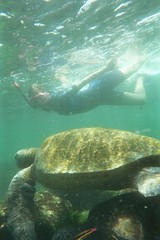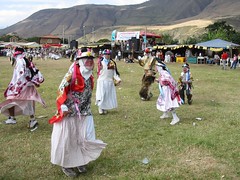
Well, I´m back from four very nice days in Cuyabeno National Park, at the far northeast corner of Ecuador. I really wasn´t sure what to expect from my trip to the jungle, although I have to admit I was quite apprehensive. I thought the bugs would drive me crazy and that I surely would be eaten alive by mosquitoes, figured I probably wouldn´t sleep because I was nervous about creepy-crawly things climbing on me, but that I would see lots of interesting wildlife. I was especially interested in seeing monkeys.
My group was 10 people from four countries: the US, France, Tahiti, and Slovenia. We had two guides. Lenin was our naturalist guide and he told us all about the wildlife. We spent some of our time walking in our gumboots and ponchos through the forest, and some of the time cruising the Cuyabena river in our motorized bark canoe looking for animals. I proved completely useless at spotting animals, while Lenin could spot an owl on a branch several trees deep in the forest. But once they were pointed out to me, I saw lots of colorful birds and butterflies, the eyes of a Cayman (like an alligator) glowing red in the light of my flashlight at night, pink dolphins, piranhas, and, yes, monkeys--several different kinds. Usually we only saw a couple at a time, sitting on branches, but on the last day as we headed out of the jungle we were rewarded for our patience. At first we only saw the branches of three or four trees moving all around as if there was a strong wind through them. But the more we looked we saw that the branches were filled with monkeys! Lenin estimated that there were about eighty of them, jumping, swinging and diving from branch to branch--tiny little squirrel monkeys and curly tailed capucin monkeys. In the evenings we also heard a strange sound--it seemed to be like a distant tornado or the noise of traffic on a highway, but really it was the bizarre sound of Red Howler Monkeys!
Aurora, our indigenous guide, showed us how the local indigenous communities use the jungle plants. She would stop as we were walking, use her ever-present machete to cut down a branch or two, and in a few minutes whip up a bracelet or a basket. She also showed us which plants are used to treat malaria, the flu, arthritis or intestinal parasites, which hallucinogenic vines are used by shaman and which branches can be whittled into poisonous darts to hunt monkeys. One evening we went back to her house and she showed us how to make bread from the yucca plant. She seemed just as fascinated by the animals as we were--she would point and laugh at the monkeys or birds and shared our curiosity and interest in the forest around us.
It was a really fun, fascinating experience, and I am most happy to report that none of the things I was apprehensive about turned out to be problems--in fact, considering we were deep in the rainforest, the accommodations were quite luxurious: we had our meals cooked and served to us, we had showers (cold of course, but really, what do you expect? It was rainwater) and real toilets. Our comfy mattresses were completely enclosed inside mosquito nets, which removed all my concerns about six- or eight-legged invaders disturbing my sleep. I had three really excellent nights´ sleep despite the fact that one night we finished our nighttime nature walk by looking around for tarantulas, and found several of them under or on the ceiling of our sleeping hut and in the bathroom! But best of all, and most unbelievably, I returned from my experience in the tropics completely mosquito-bite-free!
For more jungle photos, click on either the tarantula above or the piranha:

Also, I got my underwater photos back from the Galapagos. Unfortunately, they´re a little disappointing (I guess I´m not going to win any awards in underwater photography) but you can see some of the animals I saw, anyway. Click on me and the turtle for the Galapagos set:


















